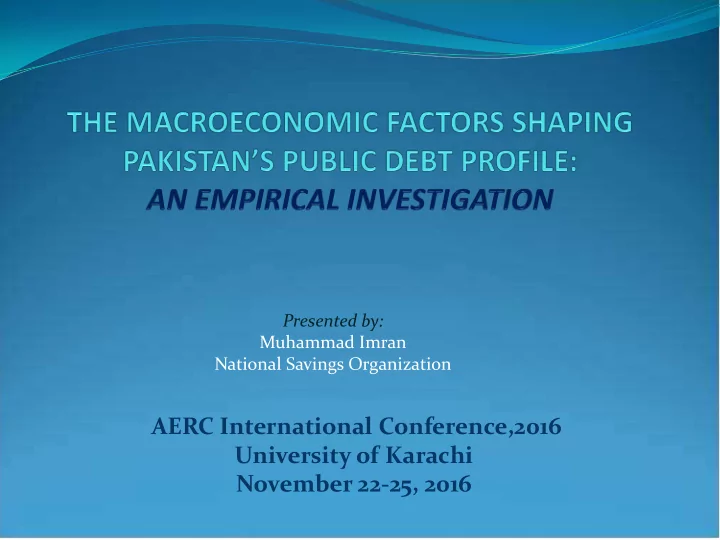

Presented by: Muhammad Imran National Savings Organization AERC International Conference,2016 University of Karachi November 22-25, 2016
Contents Public Debt Profile of Pakistan Research Objectives and Hypothesis Methodology Empirical findings Conclusion
Terminology Public Debt means debt contracted by the Federal Government and includes the guarantees extended by the GOP; Autocratic Regime means the military regime; Democratic Regime means when power is into the hands of political leaders i.e the chief executive gets selected through ballot ;
Selected Public Debt Indicators of Pakistan Table 1.1: Selected Public Debt Indicators (%) 2010 2011 2012 2013 2014 2015 Revenue Balance / (1.7) (3.3) (a) (4.5) (b) (2.9) (c) (0.7) (1.7) GDP* Primary Balance / (1.6) (2.5) (a) (4.2) (b) (3.6) (c) (0.2) (0.5) GDP* Fiscal Balance / (6.2) (6.5) (a) (8.8) (b) (8.2) (c) (5.5) (5.3) GDP Public Debt / GDP 60.6 58.9 63.3 63.9 63.8 63.5 Public Debt / 433.4 477.9 494.7 479.2 439.8 442.1 Revenue Debt Service / 40.4 38.0 39.9 40.5 40.1 40.4 Revenue Debt Service / GDP 5.6 4.7 5.1 5.4 5.8 5.1 Note: *Adjusted for grants Source : DPCO, Ministry of Finance (MOF) (a) includes arrears of electricity subsidies amounting to Rs.120 billion or 0.7 percent of GDP (b) includes "one off" payment of Rs.391 billion on account of debt consolidation or 2 percent of GDP (c) includes payment for the resolution of the circular debt amounting to Rs.322 billion or 1.4 percent of GDP
(Rs. in Trillion) 10 12 14 16 18 0 2 4 6 8 1971 Trends of Pakistan’s Public Debt 1972 1973 1974 1975 1976 1977 1978 1979 1980 1981 Domestic Debt 1982 1983 1984 1985 1986 1987 1988 1989 1990 1991 1992 1993 External Debt 1994 1995 1996 1997 1998 1999 2000 2001 2002 2003 2004 2005 2006 2007 2008 2009 2010 2011 2012 2013 2014
Research Objectives & Questions Research Objectives: To examine the debt-inflation nexus in the case of Pakistan. To analyze the impact of economic growth on the public debt in Pakistan. To measure the impact of Openness of the economy on the public debt in Pakistan. Research Questions: Is Inflation, major factor which reduces the public debt in Pakistan? How does economic growth reduces public debt in Pakistan? Does openness have a disciplinary impact on the public debt in Pakistan?
Contribution Macroeconomic factors of public debt : Inflation as a determinant ; Growth has been taken as an explanatory variable; Openness relationship with debt has been studied; Bounds testing has been used first time for public debt in case of Pakistan. Regime wise impact Earlier regime wise no empirical study was conducted
Methodology
Methodology Data Sources Debt Statistics from IMF website Macroeconomic Indicators from World Bank Development Indicators Data Definition Openness= Aggregate of Exports & Imports Inflation= CPI ODA=Foreign Aid GDPC=GDP per Capita=Growth
ARDL Long Run Model (SBC Criteria) ARDL Long Run Model with Log Public Debt as Dependent variable Model 1 Model 2 Model 3 Model 4 Model 5 Model 6 Model 7 Variables -0.0293** -0.0283** -0.0388** 0.0372** -0.0377** -0.0382** -0.0401** INF (0.0171) (0.0117) (0.0176) (0.0170) (0.0168) (0.0183) (0.0160) 0.0980*** -0.1128** -0.1013** -0.1123** -0.0733** -0.1085 ** GDPC (0.0338) (0.0471) (0.0467) (0.0478) (0.0346) (0.0455) -0.4323 -0.3157 -0.3378 -0.4535 0.1792** OPEN (0.6920) (0.6959) (0.6764) (0.7301) (0.5465) No. of Observation 41 41 41 41 41 41 41 s R-Squared 0.2575 0.5234 0.5616 0.5520 0.5531 0.5489 0.7716 - 0.2791** -0.3275*** -0.2444*** -.2539*** -0.2548*** -0.2446*** -0.2043*** (0.1056) (0.0896) (0.0833) (0.0863) (0.0860) (0.0845) (0.0612)
ARDL Long Run Model (AIC Criteria) ARDL Long Run Model with Log Public Debt as Dependent variable Variables Model 1 Model 2 Model 3 Model 4 Inflation (CPI) -0.0293** -0.0374** - 0.0319** -0.0377** (0.0171) (0.0153) (0.0127) (0.0186) GDP per -0.1026** -.0973*** - 0.1033** Capita (0.0401) (0.0343) (0.0513) Openness -0.0353 0.2243 (0.5399) (0.6471) No. of Observations 41 41 41 41 -0.2791** -0.2889*** -0.3056*** -0.1745** (0.1056) (0.0968) (0.0891) (0.0698) R-Squared 0.2575 0.5519 .5829 0.7815
Robustness Analysis Variables Model 1 Model 2 Model 3 Model 4 Inflation (CPI) -0.0293** -0.0374** - 0.0319** -0.0377** (0.0171) (0.0153) (0.0127) (0.0186) GDP per Capita -0.1026** -.0973*** - 0.1033** (0.0401) (0.0343) (0.0513) Openness -0.0353 0.2243 (0.5399) (0.6471) Exchange Rate -0.0554 (0..0787) No. of Observations 41 41 41 41 R-Squared 0.2575 0.5519 .5829 0.7815 -0.2791** -0.2889*** -0.3056*** -0.1745** (0.1056) (0.0968) (0.0891) (0.0698)
Regime and Public Debt (Democratic Regimes) ARDL Long Run Model with Log Public Debt as Dependent variable Variables Model 1 Model 2 Model 3 (AIC) (P2) (SBC) INF -0.0390*** -0.0390*** -0.0356*** (0.0110) (0.0104) (0.0110) GDPC - 0.0198 0.0204 - 0.0198 (0.0246) (0.0246) (0.0354) No. of Observations 21 21 21 - 0.6609 -0.7091*** - 0.6609*** (0.1781) (0.1781) (0.2003) R-Squared 0.7201 0.7201 0.7172
Regime and Public Debt (Autocratic Regimes) ARDL Long Run Model with Log Public Debt as Dependent variable Model 2 Model 3 Variables Model 1 (AIC) (P2) (SBC) INF - 0.0180 - 0.0131 - 0.0382** (0.0148) (0.0130) (.02077) GDPC - 0.0932** -0.0775** -0.0454 (0.0513) (0.0402) (0.0390) 20 No. of Observations 20 20 - 0.2535** - 0.2908** -0.4600** (0.1159) (0.1163) (0.2421) R-Squared 0.3430 0.3756 0.2252
Main Findings Inflation and Growth(GDP/Capita) are the major macroeconomic determinants/ reducing factors of Public Debt Openness of the economy does not have any significant effect on the Public Debt dynamics in Pakistan Inflation is the major factor having a declining effect on public debt in Democratic Regimes Growth is the potent factor which reduces public debt during autocratic regimes.
Conclusion Inflation reduces the debt during democratic regimes Growth reduces the debt during the autocratic regimes.
Recommend
More recommend